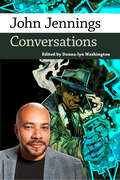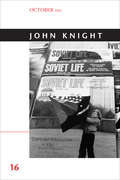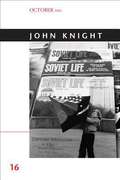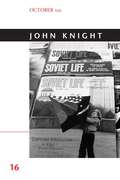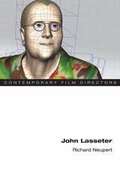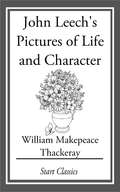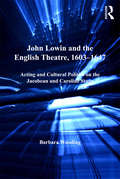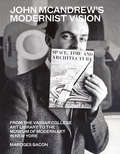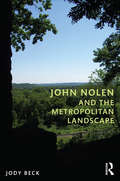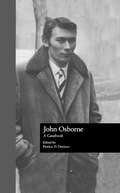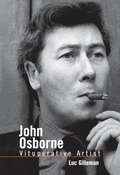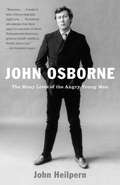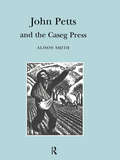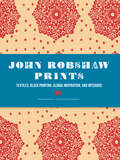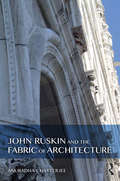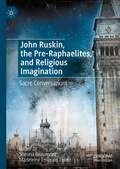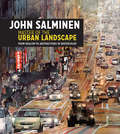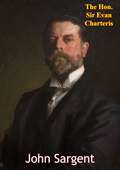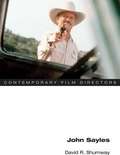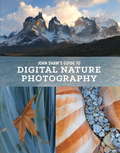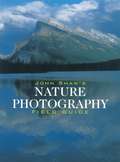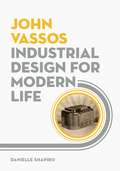- Table View
- List View
John Jennings: Conversations (Conversations with Comic Artists Series)
by Donna-Lyn WashingtonJohn Jennings (b. 1970) is perhaps best known for his collaboration with Damian Duffy on the New York Times bestseller and Eisner Award–winning graphic novel adaptation of Octavia Butler’s Kindred. However, Jennings is also a graphic designer and comic book scholar who, throughout his career, has conducted several interviews that shed light on the importance of Black Speculative narratives. The most enlightening of his interviews are brought together in John Jennings: Conversations.As a collective these interviews explore folklore, systemic racism, his Mississippi roots, and the phrase Jennings cocreated, the Ethnogothic. Jennings discusses the necessity for black heroes, not just for the sake of diversity, but for inclusiveness, touching on the conventions he has cofounded, such as the Schomburg Center’s Black Comic Book Festival in Harlem. He addresses the struggle to be financially compensated for work, and he speaks at length about how being a professor informs his craft where he continues to examine black stereotypes in popular culture with courses of his own design. As a group the interviews in John Jennings: Conversations give a picture of a black man forging a way where comic books have afforded him a means to carve out an important space for people of color.
John Knight (October Files #16)
by André RottmannEssays and interviews discuss the art of John Knight, a pioneering figure in site-specific art and institutional critique.For more than four decades, the elusive but influential Los Angeles-based artist John Knight has developed a practice of site specificity that tests both architectural and ideological boundaries of the museum, gallery, and public sphere. Knight's works defy notions of stylistic coherence, even, at times, of instant recognizability. Grounded in a sustained method of inhabiting the material, discursive and economic conditions of varied sites, his works systematically challenge notions of object, sign, context, authorship, and value, and they confront audiences not only with mailers, posters, and journals but also with carpenter levels, commemorative plates, deck chairs, bicycle bells, flower arrangements, and credit cards. This volume offers essays and interviews that trace the critical thinking on Knight, discussing the artist's trajectory from 1969 to 2011.These texts, by such prominent figures as Benjamin H. D. Buchloh, Anne Rorimer, Alexander Alberro, and Birgit Pelzer, offer close readings of Knight's pivotal projects in situ while also considering them in terms of such art-historical paradigms as the readymade, the anti-aesthetic, institutional critique, and the relationship between art and design as well as corporate culture at large. The book provides the first collection of these often hard-to-find texts on Knight and will serve as an essential guide for further consideration of his oeuvre.
John Knight
by André RottmannFor more than four decades, the elusive but influential Los Angeles-based artist John Knight has developed a practice of site specificity that tests both architectural and ideological boundaries of the museum, gallery, and public sphere. Knight's works defy notions of stylistic coherence, even, at times, of instant recognizability. Grounded in a sustained method of inhabiting the material, discursive and economic conditions of varied sites, his works systematically challenge notions of object, sign, context, authorship, and value, and they confront audiences not only with mailers, posters, and journals but also with carpenter levels, commemorative plates, deck chairs, bicycle bells, flower arrangements, and credit cards. This volume offers essays and interviews that trace the critical thinking on Knight, discussing the artist's trajectory from 1969 to 2011. These texts, by such prominent figures as Benjamin H. D. Buchloh, Anne Rorimer, Alexander Alberro, and Birgit Pelzer, offer close readings of Knight's pivotal projects in situ while also considering them in terms of such art-historical paradigms as the readymade, the anti-aesthetic, institutional critique, and the relationship between art and design as well as corporate culture at large. The book provides the first collection of these often hard-to-find texts on Knight and will serve as an essential guide for further consideration of his oeuvre.
John Knight
by André RottmannFor more than four decades, the elusive but influential Los Angeles-based artist John Knight has developed a practice of site specificity that tests both architectural and ideological boundaries of the museum, gallery, and public sphere. Knight's works defy notions of stylistic coherence, even, at times, of instant recognizability. Grounded in a sustained method of inhabiting the material, discursive and economic conditions of varied sites, his works systematically challenge notions of object, sign, context, authorship, and value, and they confront audiences not only with mailers, posters, and journals but also with carpenter levels, commemorative plates, deck chairs, bicycle bells, flower arrangements, and credit cards. This volume offers essays and interviews that trace the critical thinking on Knight, discussing the artist's trajectory from 1969 to 2011. These texts, by such prominent figures as Benjamin H. D. Buchloh, Anne Rorimer, Alexander Alberro, and Birgit Pelzer, offer close readings of Knight's pivotal projects in situ while also considering them in terms of such art-historical paradigms as the readymade, the anti-aesthetic, institutional critique, and the relationship between art and design as well as corporate culture at large. The book provides the first collection of these often hard-to-find texts on Knight and will serve as an essential guide for further consideration of his oeuvre.
John Lasseter (Contemporary Film Directors)
by Richard NeupertCelebrated as Pixar's "Chief Creative Officer," John Lasseter is a revolutionary figure in animation history and one of today's most important filmmakers. Lasseter films from Luxo Jr. to Toy Story and Cars 2 highlighted his gift for creating emotionally engaging characters. At the same time, they helped launch computer animation as a viable commercial medium and serve as blueprints for the genre's still-expanding commercial and artistic development. Richard Neupert explores Lasseter's signature aesthetic and storytelling strategies and details how he became the architect of Pixar's studio style. Neupert contends that Lasseter's accomplishments emerged from a unique blend of technical skill and artistic vision, as well as a passion for working with collaborators. In addition, Neupert traces the director's career arc from the time Lasseter joined Pixar in 1984. As Neupert shows, Lasseter's ability to keep a foot in both animation and CGI allowed him to thrive in an unconventional corporate culture that valued creative interaction between colleagues. The ideas that emerged built an animation studio that updated and refined classical Hollywood storytelling practices--and changed commercial animation forever.
John Leech's Pictures of Life and Character
by William Makepeace ThackerayWilliam Makepeace Thackeray's "John Lecch's Pictures of Life and Characters" focuses around his opinions of the works of English caricaturist and illustrator, John Leech (29 August 1817 - 29 October 1864).
John Lowin and the English Theatre, 1603–1647: Acting and Cultural Politics on the Jacobean and Caroline Stage (Studies in Performance and Early Modern Drama)
by Barbara WoodingEven for scholars who have devoted their careers to the early modern theatre, the name John Lowin may not instantly evoke recognition-until now, the actor's life and contribution to the theatre of the period has never been the subject of a full-length publication. In this study, Barbara Wooding provides a comprehensive overview of the life and times of Lowin, a leader of the King's Men's Company and one of the greatest actors of the seventeenth century. She examines his involvement in the Jacobean/Caroline world as performer, citizen and company manager, and contextualizes his life and career within the socio-economic and political framework of the period. Although references to him in the archives are patchy and sporadic, information about his activities within the King's Men's Company is well documented. In the course of analysing less familiar plays of the period and the characters Lowin played in them, Wooding supplements critical understanding of the scope and range of Caroline drama. Because Lowin's career burgeoned after Shakespeare's and Burbage's death, his life in Southwark and his career with the same company furnishes the opportunity for an examination of the changing status of actors, and the exercising of their skills within the drama of the later playhouse period.
John McAndrew's Modernist Vision: #N/A
by Mardges BaconJohn McAndrew's Modernist Vision tells the compelling story of the architect, scholar, and curator John McAndrew, who played a key role in redefining modernism in the United States from the 1930s onward. The designer of the Vassar College Art Library—arguably the first modern interior on a college campus—and the curator of architecture at the Museum of Modern Art in New York from 1937 to 1941, McAndrew was instrumental in creating a distinct and innovative aesthetic that bridged the European modernist lineage and American regional vernacular. Providing a fascinating glimpse into McAndrew's life, his associations with important architects and artists, and the historical context that shaped his work, this book is a thoroughly researched testament to a man who left a powerful mark on the evolution of American architecture.
John Nolen and the Metropolitan Landscape
by Jody Beck"A model city, the hope of democracy" – John Nolen on his suggested plans for Madison, Wisconsin This book connects John Nolen's political and social visions with his design proposals by analyzing his extensive writings, personal correspondence and some of his most significant works. While John Nolen is best known as a city planner, he trained as a landscape architect and used the titles 'landscape architect' and 'city planner' interchangeably throughout his career. A prolific practitioner, he was engaged in nearly 400 projects throughout the United States between 1905 and 1936, including town planning, industrial housing, state and city parks, new towns and regional planning. Focusing particularly on several projects central to Nolen’s career including Madison (WI), Mariemont (OH), Venice (FL) and Penderlea (NC), Beck investigates the ideologies that underpinned Nolen’s work. This is a rare look at a key figure in the development of 20th century American cities.
John Osborne: A Casebook (Casebooks on Modern Dramatists #16)
by Patricia D. DenisonFor British playwright, John Osborne, there are no brave causes; only people who muddle through life, who hurt, and are often hurt in return. This study deals with Osborne's complete oeuvre and critically examines its form and technique; the function of the gaze; its construction of gender; and the relationship between Osborne's life and work. Gilleman has also traced the evolution of Osborne's reception by turning to critical reviews at the beginning of each chapter.
John Osborne: Vituperative Artist (Studies in Modern Drama)
by Luc GillemanFor British playwright, John Osborne, there are no brave causes; only people who muddle through life, who hurt, and are often hurt in return. This study deals with Osborne's complete oeuvre and critically examines its form and technique; the function of the gaze; its construction of gender; and the relationship between Osborne's life and work. Gilleman has also traced the evolution of Osborne's reception by turning to critical reviews at the beginning of each chapter.
John Osborne: The Many Lives of the Angry Young Man
by John HeilpernJohn Osborne, the original Angry Young Man, shocked and transformed British theater in the 1950s with his play Look Back in Anger. This startling biography-the first to draw on the secret notebooks in which he recorded his anguish and depression-reveals the notorious rebel in all his heartrending complexity. Through a working-class childhood and five marriages, Osborne led a tumultuous life. An impossible father, he threw his teenage daughter out of the house and never spoke to her again. His last written words were "I have sinned." Theater critic John Heilpern's detailed portrait, including interviews with Osborne's daughter, scores of friends and enemies, and his alleged male lover, shows us a contradictory genius--an ogre with charm, a radical who hated change, and above all, a defiant individualist.
John Paizs's Crime Wave
by Jonathan BallJohn Paizs's 'Crime Wave' examines the Winnipeg filmmaker's 1985 cult film as an important example of early postmodern cinema and as a significant precursor to subsequent postmodern blockbusters, including the much later Hollywood film Adaptation. Crime Wave's comic plot is simple: aspiring screenwriter Steven Penny, played by Paizs, finds himself able to write only the beginnings and endings of his scripts, but never (as he puts it) "the stuff in-between." Penny is the classic writer suffering from writer's block, but the viewer sees him as the (anti)hero in a film told through stylistic parody of 1940s and 50s B-movies, TV sitcoms, and educational films.In John Paizs's 'Crime Wave,' writer and filmmaker Jonathan Ball offers the first book-length study of this curious Canadian film, which self-consciously establishes itself simultaneously as following, but standing apart from, American cinematic and television conventions. Paizs's own story mirrors that of Steven Penny: both find themselves at once drawn to American culture and wanting to subvert its dominance. Exploring Paizs's postmodern aesthetic and his use of pastiche as a cinematic technique, Ball establishes Crime Wave as an overlooked but important cult classic.
John Petts and the Caseg Press (Routledge Revivals)
by Alison SmithThis title was first published in 2000: John Petts (1914-1991) is one of the outstanding wood-engravers of the twentieth century. His stunning prints featuring Welsh mountains and the people who live amongst them reflect his deep concern for the history of the land and are distinguished by his profound understanding of the physical and psychological properties of light. Extensively illustrated, John Petts and the Caseg Press spans the entire career of this reclusive artist and offers the first account of the private press he founded in Snowdonia in 1937. In 1935, John Petts and Brenda Chamberlain abandoned their studentships at the Royal Academy Schools, London for a rundown farmhouse in the rugged terrain of Snowdonia. They started the Caseg Press in 1937 in the hope that it might finance their freedom to work. At first dedicated to saleable ephemera such as Christmas cards and bookplates, the press later became involved in the broader Welsh cultural scene, providing illustrations for the Welsh Review, a monthly literary periodical. In 1941, with the writer Alun Lewis, the Caseg press produced a series of broadsheets designed to express continuity and identification with the life of rural Wales in the face of social change precipitated by the second world war. John Petts and the Caseg Press is the first monograph on this artist. It covers both his work for the Caseg Press and for other publishers such as the Golden Cockerel Press. The volume offers a unique insight into an important chapter in the history of private presses in Britain and the development of neo-romanticism in art and literature during the inter-war period.
John Robshaw Prints: Textiles, Block Printing, Global Inspiration, and Interiors
by John RobshawDesign enthusiasts and armchair travelers will love circling the globe with celebrated textile designer John Robshaw. From batiks in Java to ikats in Thailand and indigo printing in India, Robshaw reveals the lush inspiration behind his signature style while highlighting step-by-step block printing techniques from local artisans and masters. Robshaw provides a rare glimpse into his creative process, wherein he blends traditional methods with his own painterly style for entirely unique creations, and shares tips for incorporating textiles into any space. Brimming with beautiful photographs of covetable textiles, far-flung destinations, and eye-catching interiors, this luxe fabric-covered book is an eclectic visual tour of the rich tradition of textile printing.
John Ruskin: The Passionate Moralist
by Joan AbseJoan Abse treats Ruskin with deep and proper respect from start to finish; and she writes best of all on his ideas about art and artists.
John Ruskin and the Fabric of Architecture
by Anuradha ChatterjeeThrough the theoretical lenses of dress studies, gender, science, and visual studies, this volume analyses the impact John Ruskin has had on architecture throughout the nineteenth and twentieth centuries. It explores Ruskin’s different ideologies, such as the adorned wall veil, which were instrumental in bringing focus to structures that were previously unconsidered. John Ruskin and the Fabric of Architecture examines the ways in which Ruskin perceives the evolution of architecture through the idea that architecture is surface. The creative act in architecture, analogous to the divine act of creation, was viewed as a form of dressing. By adding highly aesthetic features to designs, taking inspiration from the 'veil' of women’s clothing, Ruskin believed that buildings could be transformed into meaningful architecture. This volume discusses the importance of Ruskin’s surface theory and the myth of feminine architecture, and additionally presents a competing theory of textile analogy in architecture based on morality and gender to counter Gottfried Semper’s historicist perspective. This book would be beneficial to students and academics of architectural history and theory, gender studies and visual studies who wish to delve into Ruskin’s theories and to further understand his capacity for thinking beyond the historical methods. The book will also be of interest to architectural practitioners, particularly Ruskin’s theory of surface architecture.
John Ruskin, the Pre-Raphaelites, and Religious Imagination: Sacre Conversazioni
by Sheona Beaumont Madeleine Emerald ThieleThis volume presents a collection of essays by leading experts which examine nineteenth century ideas about Christian theology, art, architecture, restoration, and curatorial practice. The volume unveils the importance of John Ruskin’s writing for today’s audience, and allies it with the dynamism of the Pre-Raphaelite religious imagination. Ruskin’s drawings and daguerreotypes, as well as Pre-Raphaelite paintings, stained glass, and engravings, are shown to be alive with visual theology: artists such as Dante Gabriel Rossetti, John Everett Millais, Edward Burne-Jones, and Evelyn de Morgan illuminate aspects of faith and aesthetics. The interdisciplinary nature of this volume encourages reflection upon praise, truth, and beauty. The aesthetic conversations between Ruskin and the Pre-Raphaelites themselves become a form of ‘sacra conversazione’.
John Salminen - Master of the Urban Landscape: From realism to abstractions in watercolor
by John SalminenTake a Journey with the Master of the Urban Landscape! John Salminen is one of the most accomplished watercolor artists working today, earning awards and recognition all over the world. Whether depicting the trees of Central Park, the architecture of San Francisco or the busy streets of Beijing, John Salminen's watercolor paintings are snapshots of urban life that are both rich in detail and universal in appeal. In Master of the Urban Landscape, Salminen shares over 150 pieces of his artwork, spanning his entire career. His early abstracts and recent plein air work in the book's Introduction set the groundwork for four chapters of remarkable watercolor paintings that highlight different aspects of his work: architectural form, organic form, human form and light and shadow. Throughout, Salminen shares the inspiration for his paintings, challenges he encountered and techniques he used to capture unique scenes from cities around the world. Embark on an amazing watercolor journey with John Salminen—Master of the Urban Landscape. "John Salminen is a master of the medium of watercolor. His sense of light and design sets him apart from his contemporaries, and he has emerged as one of the finest living artists of our times with a style very much his own." --Dean Mitchell
John Sargent
by The Hon. Sir Evan CharterisThe career of John Sargent, perhaps the greatest painter of his time, and surely one of the greatest portrayers and interpreters of it in his famous portraits of its most eminent and most representative figures, is here chronicled in successive stages.The figure of the hero stands out in high relief from the narrative which his personality pervades. A wealth of anecdote and of letters enriches the record of work, travel, and triumph, from student days under Carolus-Duran to the time when the presidency of the Royal Academy could have been his; and in all this opulent detail the character of the man overshadows even the distinction of the artist as the true theme of the book.
John Sayles (Contemporary Film Directors)
by David R. ShumwayJohn Sayles is the very paradigm of the contemporary independent filmmaker. By raising much of the funding for his films himself, Sayles functions more independently than most directors, and he has used his freedom to write and produce films with a distinctive personal style and often clearly expressed political positions. From The Return of the Secaucus Seven to Sunshine State, his films have consistently expressed progressive political positions on issues including race, gender, sexuality, class, and disability. In this study, David R. Shumway examines the defining characteristic of Sayles's cinema: its realism. Positing the filmmaker as a critical realist, Shumway explores Sayles's attention to narrative in critically acclaimed and popular films such as Matewan, Eight Men Out, Passion Fish, and Lone Star. The study also details the conditions under which Sayles's films have been produced, distributed, and exhibited, affecting the way in which these films have been understood and appreciated. In the process, Shumway presents Sayles as a teacher who tells historically accurate stories that invite audiences to consider the human world they all inhabit.
John Shaw's Guide to Digital Nature Photography
by John ShawPhotography legend John Shaw returns with his much-anticipated guide to digital nature photography, complete with more than 250 extraordinarily beautiful photographs. For over four decades, John Shaw&’s authentic voice and trusted advice has helped photographers achieve impressive shots in the great outdoors. In his first-ever book on digital photography, Shaw provides in-depth advice on everything from equipment and lenses to thorough coverage of digital topics including how to use the histogram. In addition, he offers inspirational and frank insight that goes far beyond the nuts and bolts of photography, explaining that successful photos come from having a vision, practicing, and then acquiring the equipment needed to accomplish the intention. Easily digestible and useful for every type of photographer, and complete with more than 250 jaw-dropping images, John Shaw&’s Guide to Digital Nature Photography is the one book you&’ll need to beautifully capture the world around you.
John Shaw's Nature Photography Field Guide
by John ShawAn updated bestseller, this book of extraordinarily beautiful photographs of nature contains state-of-the-art instruction on how any photographer can aim for equally impressive results every time a camera is focused on the great outdoors. Even highly skilled photographers are often baffled by the problems facing them when they work outdoors. But with this exceptional field guide in hand, every photographer--beginner, serious amateur, semi-pro, and pro--can conquer the problems encountered in the field. Using his own exceptional work as examples, the author discusses each type of nature subject and how to approach photographing it. Specific advice and information cover selection of equipment and lenses; how to compose a shot; how to get close ups; and other tips covering a range of techniques to enrich various types of nature photographs.From the Trade Paperback edition.
John Vassos: Industrial Design for Modern Life
by Danielle ShapiroWhat should a television look like? How should a dial on a radio feel to the touch? These were questions John Vassos asked when the Radio Corporation of America (RCA) asked him to design the first mass-produced television receiver, the TRK-12, which had its spectacular premier at the 1939 New York World&’s Fair. Vassos emigrated from Greece and arrived in the United States in 1918. His career spans the evolution of central forms of mass media in the twentieth century and offers a template for understanding their success. This is Vassos&’s legacy—shaping the way we interact with our media technologies. Other industrial designers may be more celebrated, but none were more focused on making radio and television attractive and accessible to millions of Americans.In John Vassos: Industrial Design for Modern Life, Danielle Shapiro is the first to examine the life and work of RCA&’s key consultant designer through the rise of radio and television and into the computer era. Vassos conceived a vision for the look of new technologies still with us today. A founder of the Industrial Designers Society of America, he was instrumental in the development of a self-conscious industrial design profession during the late 1920s and 1930s and into the postwar period. Drawing on unpublished records and correspondence, Shapiro creates a portrait of a designer whose early artistic work in books like Phobia and Contempo critiqued the commercialization of modern life but whose later design work sought to accommodate it.Replete with rich behind-the-product stories of America&’s design culture in the 1930s through the 1950s, this volume also chronicles the emergence of what was to become the nation&’s largest media company and provides a fascinating glimpse into its early corporate culture. In our current era of watching TV on an iPod or a smartphone, Shapiro stimulates broad discussions of the meaning of technological design for mass media in daily life.
John Walker's Passage
by Darrell VargaJohn Walker is one of Canada's most prolific and important documentary filmmakers and is known for his many thoughtful, personally inflected films. His masterwork, Passage, centres on Sir John Franklin's failed expedition to find the final link of the Northwest Passage connecting the Atlantic and Pacific oceans through the Canadian Arctic. It also gives us the story of John Rae, the Scottish explorer who discovered the fate of Franklin and the final link in the passage, but was left to the margins of history. Walker's film brings to this story a layering of dramatic action and behind-the-scenes documentary footage that build tension between the story of the past and interpretations of the present.Darrell Varga provides a close analysis of Passage, situating it within Walker's rich body of work and the Canadian documentary tradition. Varga illuminates how the film can be viewed through the lens of Harold Innis's theories of communication and culture, opening up the work of this great Canadian political economist to film studies.
